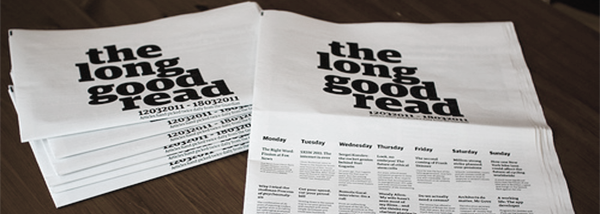by Vincenzo Marino – translated by Roberta Aiello
«Why I hate Twitter»
One of the articles on the media which has been discussed this week on the net is «Why I hate Twitter» by Matt K. Lewis in The Week. Exasperated by the «noise» of Twitter, which has become a sort of «dark place», Lewis explains the reasons that led him to consider the social network a kind of «prison». Impossible to leave for professional reasons, appreciated in the beginning, Twitter has turned, over the years, into a network dominated by factionalism and jokes (here the discussion of last week). For Lewis, Twitter is not an aggregator of ideas, but of unbearable personal problems and superficial judgments. A flow in which it becomes difficult to continue to use the means for journalistic purposes. Although Lewis admits that he has recommended aspiring journalists practice with Twitter, he affirms that it distracts from the profession and leads to reading – or joining – «small petty battles». It looks metaphorically more and more like the degenerative idea of the ‘free love’ concept typical of the 1960s that produced, according to the author, people like Charles Manson.
The post has encountered some inevitable irony on Twitter. Certifying the crux of the criticism of The Week, Julie Moos of Poynter found its strongest criticism in an article by Choire Sicha for The Awl. The author’s thesis intends to dismantle the entire system of Lewis’s argument starting from a ‘technical’ premise. It cannot be Twitter itself that led to the degeneration, because it is a social media on which one chooses freely the feed to follow. Unless you want it, it is not possible to be subjected to your own timeline, because you can change it, anytime. Rebecca Greenfield, on The Atlantic Wire, notes that the Twitter following of Lewis amounts to more than 5,000, an unusually large number for a communications professional, many of whom apparently are unnecessary and ‘eradicable’.
«So if you can’t simply unfollow people you don’t care about, or block people that gross you out, you need to go back to therapy», Sicha retorts. The ‘defense’ of Twitter, by Sicha, albeit not particularly enthusiastic of the means, doesn’t avoid stigmatizing Lewis’s combination of the free love generation and Manson with Twitter. As in the style of The Awl, Sicha makes fun of the author criticized: «Most everything that you consume on Twitter is because you chose it. And if you can’t live with what you’ve made for yourself, you should definitely make like Matt K. Lewis and leave. Then you’ll be safe. Until you publish a piece about it. And everyone makes fun of you on Twitter». The debate ends with the reply of Paul Brandus, also on The Week, who explains the reasons of his love for the San Francisco social network (source, media, inspiration, great means for those who want to do journalism without opinions).
Academic research on digital media
This week NiemanLab published an article edited by Journalist’s Resource – a project of the Shorenstein Center on Media and Social Sciences – that attempts to create a picture of the latest academic research in the field of digital media. Twitter is obviously the protagonist of more than one study. The research of the University of Sheffield focuses on social media as a tool for disseminating breaking news, from the experience of Paul Lewis (The Guardian) and that of Ravi Somaiya (The New York Times) during the London riots of 2011. Lewis and Somaiya have different ‘publishing’ strategies for the use of the medium and different feedback, in a context that imposes new ethical rules and journalistic conventions for professionals.
Dynamics that require changes in the field are the theme of a study conducted by the University of Gothenberg on how the internet and mobile news have redefined the whole context including the redesigning of the customer profile. A study by the New School for Social Research speaks of «produsage», a buzzword recently used to show the cancellation of the distinction between producers (media) and customers (audience). It is the emergence of a new actor, the producer-consumer who is able to ‘inhabit’ both spheres and participate in a renewed news market, where it is possible to draw a silhouette based on some empirical data (‘simple’ reader users make under a thousand tweets, the produsage area is between 8,000 and 25,000 messages).
Another study was conducted by the Hebrew University of Tel Aviv with the analysis of data of twenty countries. It focuses on the influence of political contexts on social network activities during the so-called Arab Spring. There are more than a few references to consequences, ethical dilemmas and paradoxes of the encounter between life and digital life. There is an analysis of what happens to our Facebook profiles after death (Pepperdine Law review), of the non-profit universe at the time of social media, with obvious reference to the “Kony 2012” case (Non-profit and voluntary sector Quarterly), and implications of the future of mobile visual devices, as the well-known Google Glass project (Boston University).
The length of articles and slow journalism
In the past few days, a debate has taken shape that has been developed around a number of figures released by the Columbia Journalism Review («Major papers’ longform meltdown») about the collapse of the longform articles in American publishing. The causes are due to staff reductions and adaptation to new tools for reading (and supply of news in general). Between 2003 to 2012, for example, there were 86% fewer pieces of more than 2,000 words at the Los Angeles Times; 50% fewer at the Washington Post, 35% fewer at the Wall Street Journal and 25% fewer at the New York Times (here some graphics). A collapse that according to Alan D. Mutter has perhaps overly upset the experts and the main consumers of newspapers – he explains – who tend to ‘still’ associate length to importance of the article, the subject or author. Whereas it is now possible to recount a story, a fact, or an interview better through new media, none of which are based exclusively on the ‘word’, but given by video, infographics or multimedia experiments.
Out of Eden Walk project, described by Evan Osnos, last Thursday, on the New Yorker website is a notable example. It is a portal built on the trip around the world by Paul Salopek that contains photos, audio, maps, graphs, which will be told through Twitter in its immediacy and that will include longform articles that the author wants to define as slow journalism. Steve Buttry suggests focusing on the value of the article itself, its contents and the needs of the public rather than its length. On the Internet experiments like Longreads and Grantland have been able to find their own established audience, and there are examples – such as The Atlantic – where the word ‘long’ is not disdained (here an example from the last few days). Most importantly – Buttry points out – data arrives from the network on readings and sharings of articles we should look at. «We should try to write the types of stories that people are going to want to share and read. That’s way more important than worrying about how long or short a story is», Buttry concludes.
Chinese hackers invade the New York Times
For four months the New York Times has been attacked by Chinese hackers. The news came from the American newspaper itself. According to the NYT the first infiltrations date back to the period in which the reporter David Barboza investigated and then published an article on the hidden fortune of Chinese Premier Wen Jiabao. The attacks, which occured again last October, would have resulted in the loss of passwords and sensitive data of journalists and employees of the newspaper with the aim of identifying the names of those who have worked with Barboza for the realization of the scoop.
The allegations of the New York Times, that were quite precise but denied categorically by Beijing, were motivated by a study conducted by computer security experts hired by the newspaper that revealed the modus operandi of ‘infiltrators’ to be like that of cyber attacks conducted by the Chinese army.
The New York Times was not the only victim (here a brief history of cyber attacks against newspapers; here the satirical version of The Onion). This week the Wall Street Journal, as well as Bloomberg Business, revealed themselves to be victims of Chinese attacks seeking information on their coverage of Beijing affairs. It is a form of a control program of the American press that records more and more episodes, from 2008 until today. According to the FBI it is considered a threat «to national security against the interest of the United States». Ryan Chittum of CJR noted, in the era of hyper-connectivity, where nothing is really safe, the real question is “who has not suffered a hacker attack by China?”.






